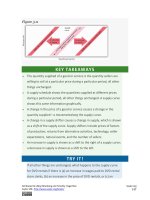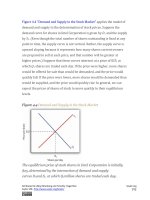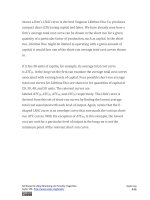Authors libby rittenberg 403
Bạn đang xem bản rút gọn của tài liệu. Xem và tải ngay bản đầy đủ của tài liệu tại đây (501.99 KB, 1 trang )
Utility is a conceptual measure of satisfaction; it is not actually measurable.
The theory of utility maximization allows us to ask how a utilitymaximizing consumer would respond to a particular event.
By following the marginal decision rule, consumers will achieve the utilitymaximizing condition: Expenditures equal consumers’ budgets, and ratios
of marginal utility to price are equal for all pairs of goods and services.
Thus, consumption is arranged so that the extra utility per dollar spent is
equal for all goods and services. The marginal utility from a particular
good or service eventually diminishes as consumers consume more of it
during a period of time.
Utility maximization underlies consumer demand. The amount by which
the quantity demanded changes in response to a change in price consists of
a substitution effect and an income effect. The substitution effect always
changes quantity demanded in a manner consistent with the law of
demand. The income effect of a price change reinforces the substitution
effect in the case of normal goods, but it affects consumption in an opposite
direction in the case of inferior goods.
An alternative approach to utility maximization uses indifference curves.
This approach does not rely on the concept of marginal utility, and it gives
us a graphical representation of the utility-maximizing condition.
CONCEPT PROBLEMS
1. Suppose you really, really like ice cream. You adore ice cream. Does
the law of diminishing marginal utility apply to your ice cream
consumption?
Attributed to Libby Rittenberg and Timothy Tregarthen
Saylor URL: />
Saylor.org
403









